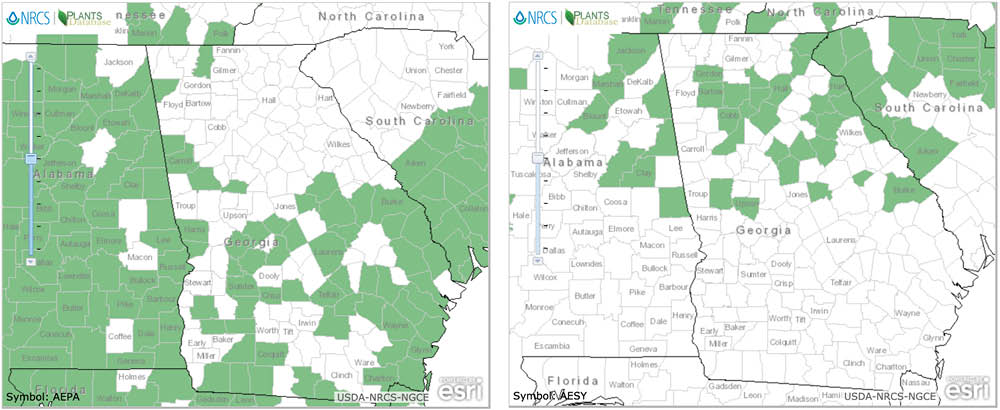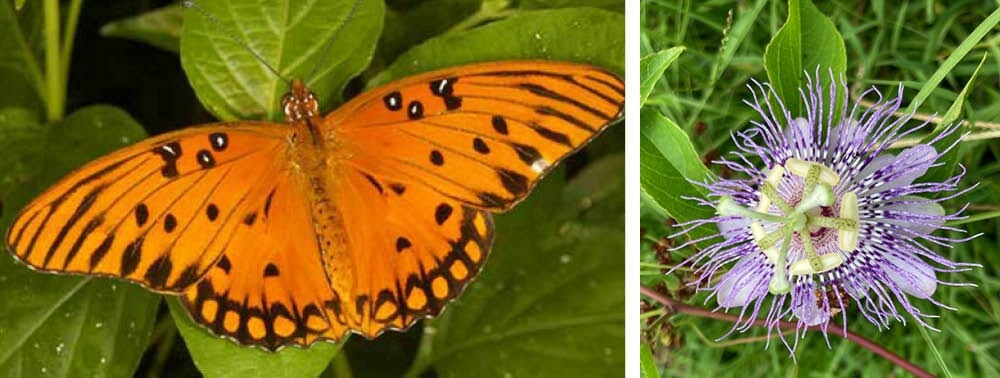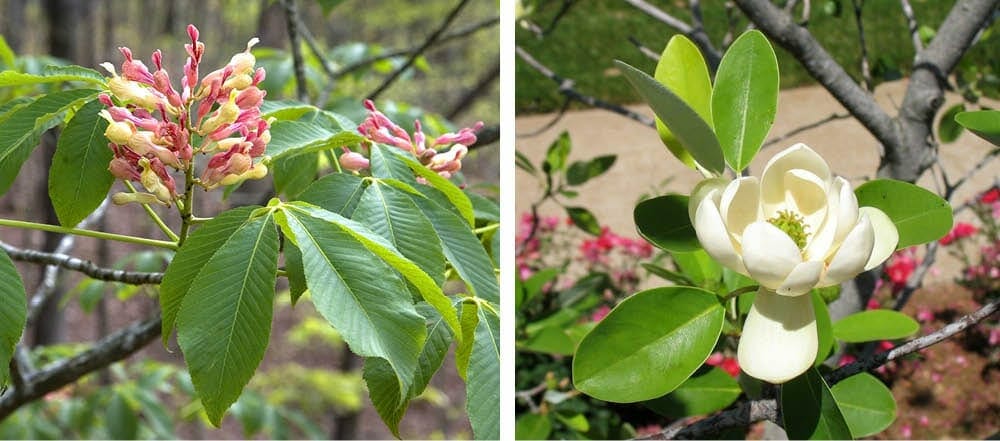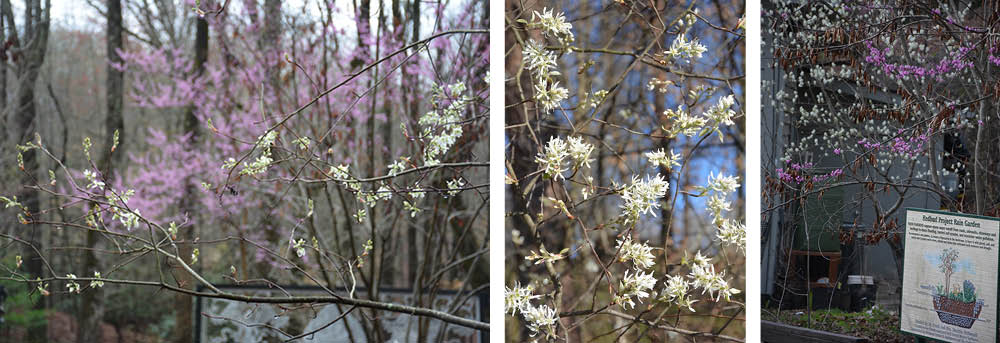
Springbeauty (Claytonia caroliniana). Photo by Kerstin Weis.
April is National Native Plant Month!
Sometimes, bipartisan legislation comes out of Congress! As noted at the site of Sen. Rob Portman (R-OH), April 2021 has been designated as National Native Plant Month. Portman comments, "I am pleased with the passage of the bipartisan resolution designating April 2021 as National Native Plant Month. From stabilizing soil and filtering air and water to providing shelter and food for wildlife, native plants play an indispensable role in supporting resilient ecosystems as well as in our everyday lives. This bipartisan resolution highlights the importance of native plants and celebrates our rich ecological heritage here in Ohio and across the nation.”
Co-sponsored by Mazie Hirono (D-HI), the bill hopes to bring attention to the importance of native plants to environmental conservation and restoration, as well as in supporting a diversity of wildlife. "Hawaii is home to nearly half of our country’s threatened and endangered plant species. Now that the Senate has passed this bipartisan resolution, during April we can celebrate and highlight how native plant species support ecosystems all across America," said Hirono.
In July 2019, Sen. Hirono co-sponsored legislation that would have
- established grant programs,
- hired more botanists in the Department of the Interior,
- required multiple federal agencies to show preference for native plants over non-native ones,
- promoted interagency cooperation related to native plants, and
- directed the National Fish and Wildlife Federation to incorporate native plant conservation into existing activities.
This legislation never passed, but the designation of April as National Native Plant Month may signal increased willingness in Congress to pass such a measure, if reintroduced.
And what a great month to introduce a new regular feature emphasizing the importance of native plants in supporting wildlife! Deborah Ashley joins us and will be the primary author of Native Fauna need Native Flora. Deborah has a degree in Forest Resources with specialization in wildlife. She's also a master gardener and previously spearheaded a project in DeKalb County at Henderson Park called the Native Plant and Wildlife Walk. Deborah now lives near Ellijay. Welcome aboard, Deborah!
Light at the End of the Tunnel — Chapter Development
Michele Buchanan
GNPS Chapter Interest Meetings were held across the state in early 2020. Momentum was building, and then the pandemic interrupted our progress. Now with vaccination numbers rising, we can see the light at the end of the tunnel. Let's take a mulligan and start again where we stopped last year! Let's do this!
GNPS members in Athens, Intown Atlanta, North Metro Atlanta, Macon, and Augusta/Central Savannah River Area expressed interest in forming new chapters. Are you in one of these areas? Please let us know if you want to be involved! If you are in an area not mentioned and want to be involved in forming a new GNPS chapter, let us know! Chapters are the future of GNPS, and we want every member to have a local chapter so they can conveniently participate in GNPS programs and activities.
What does it take to start a new chapter? Ten or more GNPS members, including four who will make up the start-up committee. The start-up committee will take care of the administrative steps of forming the chapter and temporarily act as the President, Vice President, Secretary, and Treasurer. Once the chapter is approved, members will vote to elect the actual chapter officers.
We have tools to help you get started, including a Zoom account to hold virtual meetings, a Chapter Quick Start Guide which will show you the steps to take to form a new chapter, and a team of people willing to help you.
If you are interested in being in one of the forming chapters, please use the emails below to get in touch.
If you are interested in forming a chapter in another area of Georgia, let us know at membership@gnps.org or use the Chapter Interest Form. We are looking forward to hearing from you and working with you!
Plant Spotlight: Buckeye
Ellen Honeycutt

Left: Red buckeye (Aesculus pavia). Right: Painted buckeye (Aesculus sylvatica).
Imagine you are a migrating hummingbird winging your way north. As you arrive in Georgia, your tiny body exhausted from a long flight, you spot a large shrub with panicles of tubular red flowers. This is red buckeye (Aesculus pavia), a native shrub whose flower is just perfect for a hummingbird’s long tongue. Its bloom cycle is perfectly timed to support the return of hummingbirds to Georgia.
As you travel northward still, you continue through red buckeye’s range for some time, and the nectar of these blossoms keeps you going even when you can’t find that sugar water that humans dispense for you. Somewhere along the way to Atlanta, you notice a change: the blooms are paler in color than before (but just as tasty). You are entering into the range of the Georgia buckeye, also called the painted buckeye (Aesculus sylvatica). In overlapping areas, you might actually be sipping from a natural hybrid of the two: Aesculus x mutabilis.

Range maps for the two buckeye species above, same order left to right.
If you continue northwest, you re-enter the range of the red buckeye. These shrubby buckeyes have kept you going all through Georgia. Now you also start to enter into tree buckeye territory: the Ohio buckeye (Aesculus glabra) and the yellow buckeye (Aesculus flava) both of which have some presence in North Georgia. But you’ll remember that those part-shade shrubs you found first helped you get this far.
Read more about our 2014 Plant of the Year, red buckeye (Aesculus pavia) on our website. It’s a wonderful shrub for the garden and will help those tiny hummingbirds every spring.

The natural hybrid, (Aesculus x mutabilis) and its range. There is no county-level data for surrounding states.
Native Plants Need Native Flora: Gulf fritillary
Deborah Ashley
The Gulf fritillary (Agraulis vanillae) is a bright orange butterfly with numerous black markings and white spots. These butterflies can be found in open, sunny habitats such as roadsides, fields, open woodlands, pastures, disturbed sites, yards, and parks. It is found extensively in the extreme southern United States, Mexico, Central America, and South America.
There is a special place in my heart for the Gulf fritillary because the first time I actually saw all phases of this butterfly, in person, was in my own garden. The only part I missed was the chrysalis. Gulf fritillary lay their tiny yellow eggs on the leaves of the passionflower (Passiflora sp.). I had several passionflower plants (Passiflora incarnata) plants growing voluntarily in my garden. As I was weeding the garden, the butterfly showed up and promptly started depositing her yellow eggs, one at a time, on the leaves of the passionflower growing there. The eggs were so delicate and tiny, that I worried that the rain would wash them away. So, I did my own very scientific test, and tried to push one of the eggs down the leaf. Well, of course, nature is so much smarter than we give her credit for, because there was something that caused the egg to stick to the leaf, as if it had been glued there. There were also caterpillars of the Gulf fritillary that had made quick work of munching the leaves. The larvae feed on the leaves of the passionflower vines and chemicals in the leaves makes them poisonous. The spines will not sting.

Left, middle: Eggs, adult, and caterpillar on passionflower. Photos by D. Ashley. Right: chrysalis. Photo by Georgia DNR.
The egg stage lasts 4 to 8 days. The caterpillar (larval) stage is usually 2 to 3 weeks. When the caterpillar is ready, it forms a chrysalis that looks like a dead leaf. This stage is between 5 to 10 days. (That makes me wonder if I had actually seen the chrysalis but didn’t recognize it for what it was.) Once the chrysalis is ready, an adult butterfly emerges. The adult can live between 2 to 4 weeks.
The adults feed on passionflower and many other native plants, including Joe pye weed (Eutrochium sp.), beggarticks (Bidens alba), blue mistflower (Conoclinium coelestinum), and cutleaf coneflower (Rudbeckia laciniata). It is a dimorphic insect, with the females being slightly larger and darker than the males.

Passionflower (Passiflora incarnata), right, is a host plant of the Gulf fritillary. Left photo by Jaret C. Daniels, © University of Florida, Institute of Food and Agricultural Sciences (UF/IFAS), used by permission. Right photo by Greg Lewis.
Chapter News: Redbud
Bringing Back the Woodlands
Spread across a once barren hillside, the Redbud Arboretum at Linwood Nature Preserve has brought back the woodlands to abate stormwater runoff, control erosion, filter air pollutants, and restore the natural habitats of plants and animals.
The purpose of creating the arboretum was to restore degraded acreage at the headwaters of a Federal stream that flows into Lake Lanier. The canopy of evergreen and deciduous native trees over an understory of herbaceous plants native to the Gainesville Ridges will enrich the ecosystems. Plant pollen and nectar attract native insects that provide high protein for birds that spread the seeds to propagate new trees that will continue to convert carbon dioxide into oxygen to maintain air quality – the cycle of life.
Redbud Arboretum is located at the south entry of Springview Drive to Linwood Nature Preserve, one block downhill off a major highway, reportedly traveled by 33,000 vehicles a day. Stormwater cascades over the site from 100 acres of impermeable roadways and buildings at a rate of 2,740,000 gallons for each inch of rain (based on information from Natural Resources Conservation Services and Chattahoochee RiverKeepers).
When the Redbud Project contracted with Gainesville Parks and Recreation to develop Linwood Nature Preserve for community access to leisure recreation in nature, the south entry to the urban forest had been clearcut to construct a pumping station for sewage from a chicken processing facility. Trees and understory were removed to the edge of the property. Unsightly riprap covered drainage areas across the construction site.

Redbud (Cercis canadensis) with their mauve-pink blossoms greet spring and visitors to Redbud Arboretum at Linwood Nature Preserve.
For the past 10 years, community volunteers have planted the arboretum of evergreen and deciduous trees, created native plant display beds, constructed raingardens, and installed permeable paving to model ecological methods for development. Drainage ditches have been filled with river rock to slow the flow of stormwater directly into the stream.
To restore the area degraded for construction of the pumping station, Redbud Project volunteers designed the arboretum to Gainesville city code that requires 18 tree units per acre be replaced on developed industrial/commercial land. On the half-acre arboretum, over 10.4 tree unit specimen trees were planted to exceed code. One acre of tree canopy can reportedly sequester carbon dioxide (CO2) polluting emissions from 26,000 vehicles a year and photosynthesizes CO2 into oxygen (O2).
Bringing the woodland habitats back across the degraded site promises multiple ecological benefits. To create tree canopy to sequester pollution, stabilize the terrain, provide food and shelter for wildlife, and encourage pollination for plant proliferation, the Redbud Arboretum features a biodiverse collection of evergreen and deciduous canopy and understory trees. The native species trees chosen for the arboretum are best suited to survive in the area’s loamy, acidic soil mixture of clay, silt, and sand; moisture levels and drainage of the 50% slope of terrain.
Redbud Arboretum Sampler
Each evergreen and deciduous tree selected for the Redbud Arboretum collection tells a story of the role it plays in the rich, natural ecosystems of north Georgia. The vast and varied collection of native plant species from the northern zones of Appalachia, Blue Ridge, Ridges and Valleys and Upper Piedmont were harbored in the Gainesville Ridges region by glaciers and upheaval of the earth’s tectonic over two million years ago.
Generally, these specimen trees require 4 to 6 hours of direct light daily; like moist but well-drained soil; provide year round interest with spring blooming flowers, summer fruit for wildlife, fall leaf color, winter sculptural beauty and wildlife shelter.
- Eastern hemlock (Tsuga canadensis) is one of the most shade-tolerant evergreens, long-lived and transplants well. Male and female flowers and showy fruit are borne on same tree in late fall. Subject to deadly hemlock woolly adelgid insect that has moved into northern Georgia and may require systemic treatment to survive and stop the spread. (SaveGeorgiasHemlocks.org)
- White oak (Quercus alba) towers 80 to 100 feet over the forest with support of its long, initial taproot. Highly sensitive to construction disturbance, the root zone needs protection. With its acorns deteriorating quickly after ripening, white oak has only 10% germination rate and is best propagated by planting acorns in deep pots to allow the tap root to develop. More than any other native tree or plant known, white oak hosts a plethora of 534 Lepidoptera species of butterfly and moth caterpillars—primary food source for migrating and breeding birds, whose dispersal of seeds propagate the forests.

Left: White oak (Quercus alba) leaves host caterpillars of over 534 species of butterflies and moths. Middle: Eastern white pine (Pinus strobus) is the tallest tree in eastern North America, easily identified with its bundles of five needles. Right: Eastern white pine fertilizes itself with its fertile pollen cones and young needles in late June. Photo by Beryl Angelus.
- Eastern white pine (Pinus strobus) Tallest tree in eastern North America, the hardy, fast growing conifer (24 inch/year) is the only pine with five needles in a bunch. The evergreen conifer is self-fertile with pollen cones amidst the needles in late June. Soft, blue-green needles make excellent herbal tea that exceeds the amount of vitamin C in lemons and oranges. It provides seeds for birds, especially red crossbills, and nesting sites for nesting sites for woodpeckers mourning doves, chickadees, nuthatches. In the 17th and 18th centuries, white pine was highly sought by the British Royal Navy for ship masts, to the chagrin of the American colonists. Their rebellion against England shipping pines to England, the Pine Tree Riot, may have fueled the Boston Tea Party in 1773 and led to the American Revolution. According to 19th century philosopher Henry David Thoreau, “There is no finer tree.”
- Bigleaf magnolia (Magnolia macrophylla) An uncommon deciduous tree with huge oblong-obovate 36-inch leaves, largest simple leaf of any tree indigenous to North America, make it vulnerable to strong winds and more suited to sheltered regions of the landscape. Showy, fragrant flowers may not bloom for 12 or more years. Spherical, cone-like fruits mature to red in late summer. Rarely found in the wild and limited to a few rich, wooded areas in river valleys of the southeastern United States. French naturalist Andre Michaux discovered this magnolia in North Carolina in 1795 and introduced it into European landscape in 1800.

Left: Co-author of The Natural Communities of Georgia Leslie Edwards admires huge 30-inch leaves of the arboretum’s bigleaf magnolia (Magnolia macrophylla). Right photo: Bigleaf magnolias bloom high up in trees only after 12 years with fragrant, white flowers in April-May that develop into spherical, cone-like fruits that mature red in late summer.
- Painted buckeye (Aesculus sylvatica) Deciduous, low-growing shrub or small tree leafs out early March ahead of overstory trees. Showy, clusters of greenish-yellow-pink resemble a paintbrush and bloom April to May to attract hummingbirds and eastern tiger swallowtail butterflies. Produces pear-shaped fruit for wildlife. Deer tolerant. Of painted buckeye, Colonial botanist William Bartram wrote: “I am continually impelled by a restless spirit of curiosity in new productions of nature. My chief happiness consists in tracing and admiring the infinite power, majesty and perfection of the great almighty Creator…that through divine aid and permission, I might be instrumental in discovering and introducing into my native country, some original productions of nature, which might become useful to society.”

Left: Painted buckeye (Aesculus sylvatica) blooms April to May with greenish-yellow-pink blooms. Right: Sweetbay magnolia (Magnolia virginiana) hosts larvae of the Sweetbay silkmoth (Callosamia securifera), provides wildlife cover and nesting sites, and is loved in urban landscapes for its fragrant, white flowers in spring and summer.
- Sweetbay Magnolia (Magnolia virginiana) A compact tree suitable for narrow corridors of urban areas is evergreen in Upper Piedmont. The elegant white flowers in spring and summer attract pollinating insects and shiny evergreen leaves are habitat for larvae of the sweetly silkmoth—read caterpillars for baby bird food. Wildlife find cover and nesting sites in the lower branches.

Left: Downy serviceberry bursts into bloom in the first days of spring along with Redbud (Cercis canadensis) blooming close behind. Middle: High in the top of downy serviceberry in very early Spring, the star-shaped blossoms serve up pollen and nectar for early birds and bees. Right: Downy serviceberry (Amelanchier arborea) blooms with plenty of nectar and pollen for bees and butterflies in very early Spring.
- Serviceberry (Amelanchier arborea) One of the first deciduous trees to bloom in spring with its five-petaled, star-shaped blossoms high in the leafless branches. Butterflies hasten to feed on plentiful nectar and pollen of the blossoms that give way to juicy berries in June that mockingbirds, bluebirds, and finches flock to before humans get a chance to enjoy. The yellow to red fall foliage adds to the year-round interest of this special tree. Its name comes from folklore that tells when serviceberry bloomed, the ground had thawed enough to dig the graves and bury the dead of winter when the circuit rider preacher arrived to hold the funeral services.
- Yellowwood (Cladrastis lutea) Declared the best medium-sized flowering tree for small to medium-sized landscape, this deciduous tree affords clear, yellow fall color. Its large, hanging clusters of fragrant, pea-like, white flowers in spring and legume pod fruit in Fall are produced only when yellowwood has grown 12 to 18 feet high, and then every three years. Its Latin name Cladrastis means “brittle branch,” a clue that limbs must be pruned to avoid breakage and ensure good branch angles. Botanist Andre Michaux discovered yellowwood in the colonial woods in winter of 1796.
|